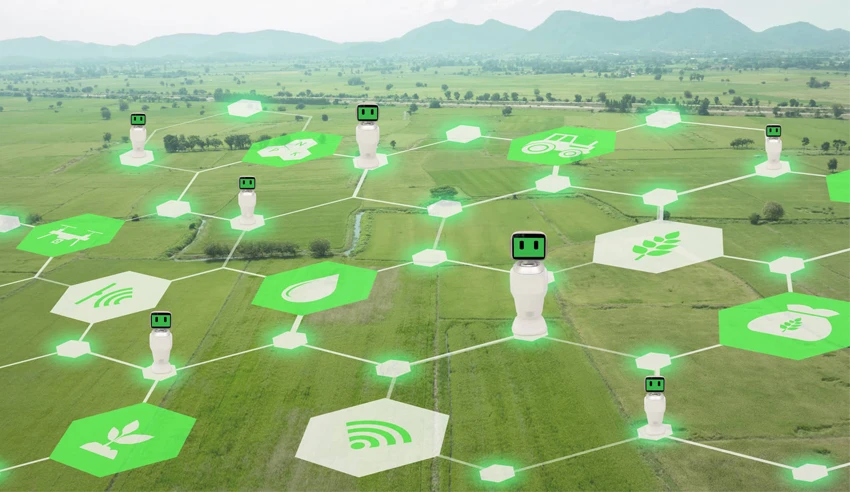News & Views

The average farm generated about 500,000 data points per day, according to a 2016 Business Insider Intelligence report. That figure is projected to grow to more than 4 million data points per day by 2034. To remain competitive, producers must harness and use that data to their advantage. Yet, turning raw data into practical, usable information has been a struggle for years.
“The domestic agricultural industry, in general, has a troubled history in this area,” says Jennifer Clarke, director of the Quantitative Life Sciences Initiative and Faculty in the Agricultural Research Division at the University of Nebraska-Lincoln. “So producers are very skittish when it comes to their data.”
To solve this problem, the USDA has tasked land-grant universities with developing a blueprint for a national data framework and cooperative where producers, universities, and not-for-profit entities can store and share data as well as create tools that enable producers to maximize production and profitability.
“The USDA understands data is important, especially as the conversation continues around capturing carbon and agricultural sustainability. It also appreciates producers’ concerns about data and security,” Clarke says.
“They see land-grant universities as a trusted partner for farmers — that’s why they’re leaning on us to spearhead the National Agricultural Producers Data Cooperative [NAPDC] project. We are not trying to profit off your data. Our goal is to build this based on the needs of producers. We want to enable you to handle your data and to learn from it.”
That also means producers must be part of the conversation. “I think a lot of them would like something similar to the co-op model, which means producers would also run it. They get a vote in deciding what happens and how this is meant to work,” she says. “We also need to be transparent about what the value will be. If a farmer is going to participate in this framework, he wants economic value at the end of the year like he’d get from a co-op.” Ultimately, the idea is to have a network of regionalized databases. “We want it to be driven by regional needs,” Clarke says. “Our job will be to keep everyone connected on a national level. For example, if someone in Vermont wants to solve issues in dairy management practices, someone in Wisconsin might be interested in being a part of that project. We can connect you with them.”
INITIAL STEPS
The NAPDC (agdatacoop.org) plans to target two areas initially. These will provide researchers and stakeholders an opportunity to be part of the foundational conversations and contribute to the conceptualization and eventual construction of a national framework.
1. Webinars. Meetings will focus on the needs of the community relative to a national distributed data framework and emerging technologies/methods to enable the framework.
2. Competitive grants program. The program is intended to enable national, regional, and/or domain-specific stakeholder groups to host meetings and encourage broad and diverse participation in blueprint development. Creating an ag data repository is not a new concept. In recent years, the Agricultural Data Coalition, AgGateway, Open Ag Data Alliance, and others have created systems designed for producers. Yet, hurdles remain.
A standardized, secure system driven and controlled by producers will address a significant need in the data space, yet it is still a relatively novel idea.
“The USDA has been talking about data for a long time, but I don’t think they were quite sure what to do in this area,” Clarke says. “I believe part of the reason the USDA has finally decided to develop this type of system is because there’s recognition within the federal government of the potential value behind smart adoption of artificial intelligence [AI] that will address issues around carbon capture, sustainability, and productivity.”
AI can help enable several scenarios for ag, including automation and precision agriculture, says Ranveer Chandra, managing director of industry research at Microsoft. “It can help fill gaps in data from the farm and also predict some values,” he says.
The caveat is that AI is only as good as your data, and you need a lot of it. “If you don’t have good data, your AI models will suffer,” Chandra says.
With a deadline of April 2023 and an initial budget of $500,000, Clarke knows this is no small feat.
“There are a lot of issues around data we’re trying to solve,” she says. “As land grant universities, our mission is to enable and educate the ag community. It’s what we do and what we are trying to accomplish with this project. We want to construct it for farmers from the ground up, and we are here to advocate for them.”
agriculture.com: https://www.agriculture.com/technology/data/how-to-get-the-most-out-of-data
How to join Oxentt ?
To join the exclusive Business Agency elite group does not require important financial contribution. It is, however, imperative that by joining all members adhere to its philosophy of ethics, respect and seriousness.
Any business owner from any country, investor, entrepreneur and corporate executives are welcome to join us.


